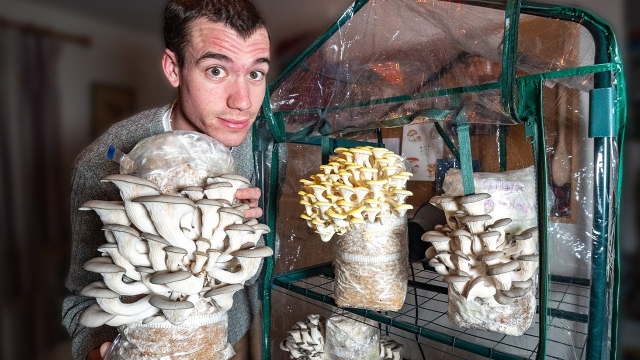
Mushrooms have long captivated our imagination with their unique textures, flavors, and therapeutic properties. From their humble origins as mysterious fungi popping up in the depths of forests, mushrooms have now become a fascinating subject for cultivation. The art of mushroom growing, also known as fungiculture, has gained popularity as more people discover the joy and excitement of nurturing these incredible organisms from start to finish.
The allure of mushroom growing lies in the intricate process of unlocking the secrets hidden within their spores. It is both a science and an art, requiring careful attention to detail and an understanding of the ideal conditions necessary for optimal growth. As aspiring mycologists delve into this magical realm, they embark on a journey filled with mystery, anticipation, and a deep appreciation for the wonders of nature. From selecting the right substrate for the chosen mushroom species to creating a conducive environment for spore germination, every step is imbued with the potential to unlock the hidden potential of these captivating organisms.
In this article, we will explore the world of mushroom growing, shedding light on the techniques, challenges, and rewards associated with this mesmerizing process. Whether you are a curious beginner wishing to embark on your first fungiculture adventure or an experienced cultivator seeking to expand your repertoire, this is your guide to unraveling the secrets of mushroom growing. Join us as we dive into the intrinsic beauty and magic that lies within the realm of fungi, and learn how you too can become a master of mushroom cultivation.
Grow Mushrooms
Types of Mushrooms for Growing
Mushroom growing is a fascinating and rewarding activity that can be pursued by enthusiasts and professionals alike. There are numerous types of mushrooms that can be grown, each with unique characteristics and requirements. In this section, we will explore three popular varieties of mushrooms that are commonly cultivated.
Button Mushroom: The button mushroom, scientifically known as Agaricus bisporus, is one of the most widely cultivated mushrooms in the world. It is prized for its mild flavor and versatility, making it a popular choice for culinary purposes. Button mushrooms have a white cap and a firm texture, making them ideal for slicing, grilling, or sautéing. These mushrooms grow best in a temperature-controlled environment, with proper humidity and ventilation.
Shiitake Mushroom: Shiitake mushrooms, scientifically known as Lentinula edodes, have gained popularity not only for their culinary uses but also for their medicinal properties. Originating from East Asia, these mushrooms have a distinctive umami flavor and a meaty texture, making them a sought-after ingredient in many Asian dishes. Shiitake mushrooms are typically grown on hardwood logs or blocks, requiring specific conditions of temperature, humidity, and air exchange.
Oyster Mushroom: Oyster mushrooms, scientifically known as Pleurotus ostreatus, are a highly adaptable and fast-growing variety. They are named for their resemblance to oyster shells with their delicate, fan-shaped caps. Oyster mushrooms come in different colors including white, gray, and yellow. With their mild and slightly nutty flavor, they are a delightful addition to stir-fries, soups, and salads. Oyster mushrooms can be cultivated on a variety of substrates such as straw, sawdust, or even coffee grounds.
By understanding the characteristics and requirements of different mushroom varieties, you can choose the type that best suits your interests and growing conditions. Whether you prefer the classic button mushroom, the flavorful shiitake, or the versatile oyster mushroom, there are endless possibilities for cultivating these remarkable fungi.
Basic Requirements for Mushroom Cultivation
To successfully cultivate mushrooms, certain factors must be taken into consideration. Here, we will discuss three crucial requirements for successful mushroom growing.
Substrate: One of the key elements in mushroom cultivation is the substrate, which serves as the food source for the mushrooms. Common substrates include sawdust, straw, compost, or a combination of these organic materials. The substrate should be pasteurized or sterilized to eliminate any competing organisms that could hinder mushroom growth.
Spawn: Spawn serves as the "seed" for mushroom cultivation. It is essentially mycelium, the vegetative part of the fungus that gives rise to the fruiting body. Spawn can be obtained commercially or generated in-house by expanding a small piece of mycelium on a nutrient-rich agar medium. Once the spawn is prepared, it is mixed with the substrate to initiate mushroom growth.
Environmental Conditions: Providing the right environmental conditions is crucial for successful mushroom cultivation. Mushrooms thrive in a cool and humid environment, with temperatures ranging between 55 to 75°F (13 to 24°C) and humidity levels around 80-90%. Adequate ventilation is also essential to ensure a constant fresh air supply without allowing contaminants to enter the growing area.
Remember, these are just the basic requirements for mushroom cultivation. Each mushroom variety may have its own specific needs, so it’s essential to research and understand the requirements of the particular mushroom species you are interested in growing.
Step-by-Step Guide to Growing Mushrooms
In this section, we will walk you through the step-by-step process of growing mushrooms. Follow these instructions carefully to unlock the secrets of mushroom growing.
Preparation: Start by gathering all the necessary materials for your mushroom growing project. You will need mushroom spores or spawn, a growing medium (such as straw, compost, or sawdust), a container or growing tray, and a clean, dark space to place your mushrooms.
Inoculation: Once you have your materials ready, it’s time to inoculate the growing medium with the mushroom spores or spawn. Depending on the type of mushrooms you’re growing, there are different methods to do this. It could involve spreading the spawn evenly on the surface of the growing medium, mixing the spawn with the substrates, or injecting it into pre-drilled holes.
Incubation: After inoculation, the next step is to provide the right conditions for the mushrooms to grow. This usually involves maintaining a constant temperature, humidity, and darkness to encourage mycelium growth. Keep the growing medium moist but not overly wet, and monitor the temperature regularly to ensure it stays within the optimal range for your chosen mushroom variety.
Fruiting: Once the mycelium has thoroughly colonized the growing medium, the fruiting stage begins. This is when the mushroom caps start to emerge. At this point, you might need to adjust the temperature, humidity, and light conditions to promote fruiting. Mist the growing medium with water to maintain humidity and ensure proper air circulation.
Harvesting: As the mushroom caps continue to develop, they will gradually mature and reach their prime harvesting stage. It’s important to harvest the mushrooms at the right time to maximize their flavor and texture. Using a sharp knife, cut the mature mushrooms close to the base, taking care not to disturb the surrounding mycelium.
Enjoying your harvest: Congratulations, you’ve successfully grown your own mushrooms! Now it’s time to savor the fruits of your labor. Cook them in various delicious recipes or simply enjoy them fresh. Remember to store any unused mushrooms properly to maintain their freshness.
By following this step-by-step guide, you’ll be able to unlock the secrets of mushroom growing and create a magical experience right in your own home. Happy cultivating!
















